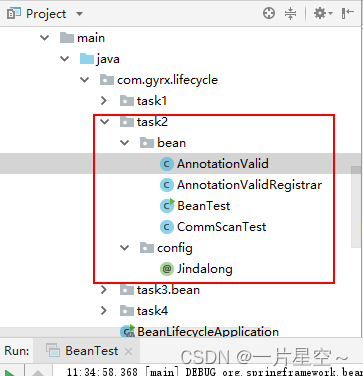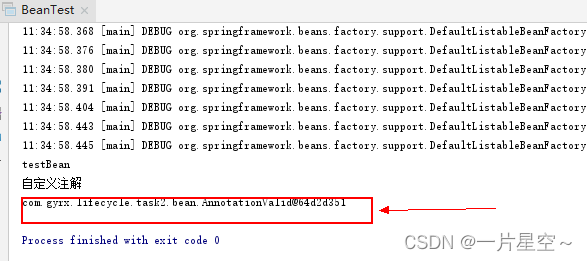目录
3.2继承BeanPostProcessor增加spring扫描配置
目录结构:

一:定义自定义注解
package com.gyrx.lifecycle.task2.config;
import org.springframework.core.annotation.AliasFor;
import org.springframework.stereotype.Component;
import org.springframework.stereotype.Indexed;
import java.lang.annotation.*;
@Target({ElementType.FIELD,ElementType.METHOD,ElementType.PARAMETER})
@Retention(RetentionPolicy.RUNTIME)
public @interface Jindalong {
String value() default "自定义注解";
}
二:使用自定义注解
3.1 定义使用注解的测试文件路径
package com.gyrx.lifecycle.task2.bean;
import org.springframework.context.annotation.ComponentScan;
@ComponentScan(value = {"com.gyrx.lifecycle.task2.bean"})
public class CommScanTest {
}
3.2继承BeanPostProcessor增加spring扫描配置
在Bean初始化的过程都会调用BeanPostProcessor接口即Spring中的后置处理器,这个接口是Spring IOC容器给我们提供扩展接口,方便在Spring容器中完成bean实例化,配置以及其他初始化方法前后添加一些自己处理的逻辑。
在bean创建好之后都会调用后置处理器的postProcessAfterInitialization方法,所以可以利用自定义这个方法,达到让spring扫描自定义注解的目的。
可以参考上一篇bean的生命周期,稍后会再次完善
package com.gyrx.lifecycle.task2.bean;
import com.gyrx.lifecycle.task2.config.Jindalong;
import org.springframework.beans.BeansException;
import org.springframework.beans.factory.FactoryBean;
import org.springframework.beans.factory.annotation.AnnotatedBeanDefinition;
import org.springframework.beans.factory.config.BeanDefinition;
import org.springframework.beans.factory.config.BeanDefinitionHolder;
import org.springframework.beans.factory.config.BeanPostProcessor;
import org.springframework.beans.factory.support.AbstractBeanDefinition;
import org.springframework.beans.factory.support.BeanDefinitionBuilder;
import org.springframework.beans.factory.support.BeanDefinitionReaderUtils;
import org.springframework.beans.factory.support.BeanDefinitionRegistry;
import org.springframework.context.EnvironmentAware;
import org.springframework.context.ResourceLoaderAware;
import org.springframework.context.annotation.ClassPathScanningCandidateComponentProvider;
import org.springframework.context.annotation.ImportBeanDefinitionRegistrar;
import org.springframework.core.annotation.AnnotationUtils;
import org.springframework.core.env.Environment;
import org.springframework.core.io.ResourceLoader;
import org.springframework.core.type.AnnotationMetadata;
import org.springframework.core.type.filter.AnnotationTypeFilter;
import org.springframework.stereotype.Component;
import org.springframework.util.Assert;
import org.springframework.util.ClassUtils;
import org.springframework.util.ReflectionUtils;
import org.springframework.util.StringUtils;
import java.lang.reflect.Method;
import java.util.HashSet;
import java.util.Map;
import java.util.Set;
@Component
public class AnnotationValidRegistrar implements BeanPostProcessor {
@Override
public Object postProcessBeforeInitialization(Object bean, String beanName) throws BeansException {
return bean;
}
@Override
public Object postProcessAfterInitialization(Object bean, String beanName) throws BeansException {
Method[] methods = ReflectionUtils.getAllDeclaredMethods(bean.getClass());
if (methods != null) {
for (Method method : methods) {
Jindalong jindalong = AnnotationUtils.findAnnotation(method, Jindalong.class);
// process
if (jindalong != null) {
System.out.println(method.getName());
System.out.println(jindalong.value());
}
}
}
return bean;
}
}四:测试
判断bean对象是否在bean工厂里面了
package com.gyrx.lifecycle.task2.bean;
import org.springframework.context.annotation.AnnotationConfigApplicationContext;
public class BeanTest {
public static void main(String[] args) {
//通过能否获取自定义注解bean对象,判断spring是否扫描到
AnnotationConfigApplicationContext annotationConfigApplicationContext = new AnnotationConfigApplicationContext();
annotationConfigApplicationContext.register(CommScanTest.class);
annotationConfigApplicationContext.refresh();
AnnotationValid userService = (AnnotationValid) annotationConfigApplicationContext.getBean("annotationValid");
System.out.println(userService);
}
}
结果截图
